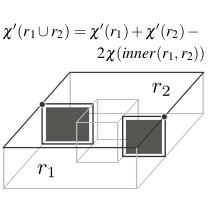
 Page d'accueil
Page d'accueil Recherches
Recherches Publications
Publications Enseignements
Enseignements Encadrement de Thèses
Encadrement de Thèses CV
CV Coordonnées
CoordonnéesCombinatorial Maps for 2D and 3D Image Segmentation
Digital Geometry Algorithms: Theoretical Foundations and Applications to Computational Imaging
Lecture Notes in Computational Vision and Biomechanics 2, pages 359-393, May 2012
Lecture Notes in Computational Vision and Biomechanics 2, pages 359-393, May 2012
Abstract: This chapter shows how combinatorial maps can be used for 2D or 3D image segmentation. We start by introducing combinatorial maps and we show how they can be used to describe image partitions. Then, we present a generic segmentation algorithm that uses and modifies the image partition represented by a combinatorial map. One advantage of this algorithm is that one can mix different criteria and use different image features which can be associated with the cells of the partition. In particular, it is interesting that the topological properties of the image partition can be controlled through this approach. This property is illustrated by the computation of classical topological invariants, known as Betti numbers, which are then used to control the number of cavities or the number of tunnels of regions in the image partition. Finally, we present some experimental results of 2D and 3D image segmentation using different criteria detailed in this chapter.
BibTex references
@InBook{DamDup12,
author = {Damiand, G. and Dupas, A.},
title = {Combinatorial Maps for 2D and 3D Image Segmentation},
booktitle = {Digital Geometry Algorithms: Theoretical Foundations and Applications to Computational Imaging},
series = {Lecture Notes in Computational Vision and Biomechanics},
publisher = {Springer},
volume = {2},
chapter = {12},
pages = {359-393},
month = {May},
year = {2012},
url = {https://dx.doi.org/10.1007/978-94-007-4174-4_12}
}
author = {Damiand, G. and Dupas, A.},
title = {Combinatorial Maps for 2D and 3D Image Segmentation},
booktitle = {Digital Geometry Algorithms: Theoretical Foundations and Applications to Computational Imaging},
series = {Lecture Notes in Computational Vision and Biomechanics},
publisher = {Springer},
volume = {2},
chapter = {12},
pages = {359-393},
month = {May},
year = {2012},
url = {https://dx.doi.org/10.1007/978-94-007-4174-4_12}
}
Image
 [Retour]
[Retour]


